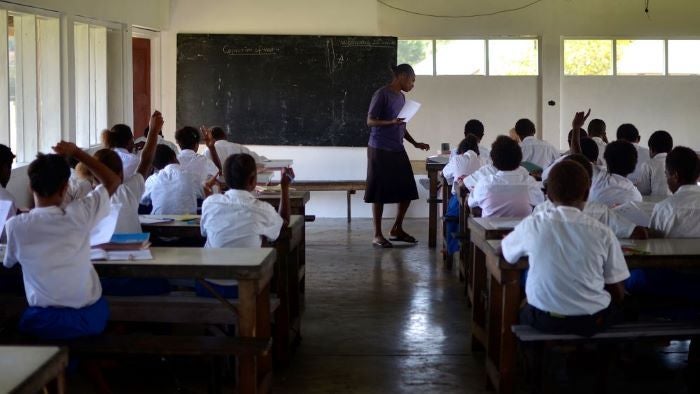 Para que seja eficaz, o desenvolvimento profissional dos professores tem de ser bem-sucedido na mudança dos seus comportamentos na sala de aula.
Para que seja eficaz, o desenvolvimento profissional dos professores tem de ser bem-sucedido na mudança dos seus comportamentos na sala de aula.
This blog was updated on 9/2/21.
This product is part of a package of tools for countries and stakeholders to support teacher professional development. Please visit this link to learn more about Coach, the World Bank’s flagship initiative on teacher in-service professional development.
For teacher professional development to be effective, it needs to be successful in changing their behaviors in the classroom. This is why professional development is so challenging, as it requires teachers to replace old habits with new ones, sometimes while also grappling with new curricula, new materials, and even new modes of teaching, like hybrid or remote teaching.
For behaviors to turn into habits, actions need to be prompted and made as easy to adapt as possible. Teachers wear many hats, and are expected to deliver high cognitive outcomes as well as balance complex socio-emotional classroom interactions. To support teachers means – among other things – supporting their decision-making in the classroom, ultimately making their jobs a little simpler.
Teachers’ Guides support decision-making in the classroom. Teachers’ Guides (TGs) refer to a set of lesson plans for teachers (they are sometimes known as scripted or structured lesson plans). TGs provide a way to “raise the foundation” of teaching quality in the classroom by supporting teachers in the process of curricula enactment – simplifying the task of providing instruction by focusing on how to teach rather than only what to teach. Well-designed TGs free up teachers’ time to engage in socio-emotional aspects of the classroom and personalize learning, without lowering the “ceiling” for high-quality teaching.
TGs are one of the most effective and cost-efficient ways to improve learning outcomes. Studies have shown that use of an effective TG, increases the rate of correct student responses within class time, increases student time on task, and improves student learning outcomes. The Global Education Evidence Advisory Panel convened jointly by the World Bank and the UK’s Foreign, Commonwealth & Development Office (FCDO) designated TGs with structured lesson plans a “Good Buy” – meaning there is good evidence that the intervention can be “highly cost effective across a variety of contexts”. They can be especially impactful in LMICs, where teachers are less trained and have fewer academic qualifications. In fact, TGs are not a permanent solution and the long-term ambition of education systems should be to gradually reduce the use of TGs as teacher expertise grows.
Not all TGs are created equal, and some TGs are better than others. The World Bank’s Coach program has created the TG Diagnostic Tool with the purpose of assessing the quality of TGs in any subject in primary Grades 1 through 4. The tool measures ease of use (i.e., how the guide supports teachers to deliver content) and quality of the pedagogical practices prescribed within each lesson. Presented in a checklist form, the Diagnostic Tool makes it easy to identify the presence or absence of essential and good-to-have components within TGs. The Diagnostic Tool assesses TGs based on two sets of criteria: Guide Criteria which looks at overall organization, structure, and level of scripting throughout the TG; and Lesson Criteria which assesses the layout, structure, and general pedagogical practices within individual lessons.
An example of TG good practice: TGs often require the incorporation of different “voices” within one lesson – what the teacher reads to him/herself, and what the teacher reads out loud to students. An example of where these two “voices” are clearly demarcated can be seen in this example taken from Grade 1 TGs in Liberia. Here, the TG clearly signals what is meant to be spoken and what is meant to be read by using “Say” and “Ask”. The voice shift is signposted, making it easier for the teacher to implement during class.
Source: USAID and Liberia MOE. 2019. Accelerated Quality Education Teacher Guides and Learner Workbooks Series, Literacy, Level 1, Semester 1. Monrovia: USAID & MOE License: Creative Commons Attribution CC BY 4.0 IGO
An example of not-so-good TG practice: Below, instructions for teachers are mixed with questions directed at the student. For example, the list of activities are a combination of teacher-facing instructions (“Demonstrate to students how to measure the length of a teacher’s table using a pencil”) and student-facing questions (“How many pencils in length are the students’ tables?”). The voice shift is not signposted, meaning that teachers have to discern on the spot what they are meant to say aloud versus what they are meant to read to themselves, making it more difficult for teachers to follow, and ultimately impacting instructional quality.
Another good practice found in literature is the gradual minimizing of scriptedness from the beginning of the year to the end of the year. This type of structure allows teachers to build a strong foundation in the beginning of the year with more precisely scripted content and adjusts the level of scriptedness as they build more confidence in teaching the class and content throughout the year. The example below, taken from Grade 1 TGs in Kenya, demonstrates how a TG can become less scripted and more open-ended as the year progresses.
Source: Department of Education, Kenya. 2016. Tusome Early Grade Reading Activity: Grade 1 English Teacher’s Guide. Prepared by RTI International and produced with support from USAID and licensed under the Creative Commons Attribution 4.0 International License.
These are not just isolated examples of diversity across TGs. A 2018 RTI study that surveyed TGs in 19 programs across 13 countries found huge variation across several indicators. For example, the average number of words per lesson by program ranged from 154 to over 3,600; average number of pages per lesson ranged from 1 to 11; and average number of activities from 1.25 to 15.5. The diversity of TGs across this sample of programs shows that guidance on what constitutes quality in TGs is both lacking and needed.
The TG Diagnostic Tool assesses the quality of existing TGs and provides guidance on how to develop of a new set of TGs. The Diagnostic Tool provides purposely evaluative criteria that draw from implementation and research evidence to make recommendations for improvement. Examples from existing public-domain TGs in LMICs (like above) demonstrate that each of the criterion are achievable standards of excellence. The Diagnostic Tool also provides the supporting literature and research evidence for each of the criterion defined in the Tool. Policymakers, program designers, and other educational stakeholders seeking to use TGs as part of an intervention can leverage the Tool to ensure that the TGs provide the appropriate and necessary guidance to teachers in order to drive improved student outcomes.
The COVID-19 pandemic has exacerbated the learning crisis, and it is clear that accelerated learning and/or restructuring of academic curricula may be necessary upon students’ return to school. To address this, the Diagnostic Tool has been developed in consideration of, and for suitable application to, accelerated education needs (for example, guidance on average lesson length has been developed with attention to catch-up needs post-COVID-19). In addition, it provides recommendations on how to embed explicit pedagogical guidance within TGs, which will be particularly critical for teachers whose professional development have been impacted due to the COVID-19 pandemic. Both habits and content will need to be revisited and in some cases even re-learned, and TGs will have a big role to play in improving and accelerating learning in the pandemic’s aftermath.
The authors of the TG Diagnostic Tool incorporated a broad range of perspectives and voices on best practices for TGs around the world. We thank all who participated in our consultations process and shared their feedback on how to make the Tool and guidance it provides comprehensive, clear, and useful for users. Please continue to reach out to us at coach@worldbank.org to share your thoughts and engage with our work!
You can find the TG Diagnostic Tool and accompanying Scoresheet at these links.
Further reading:
- For more on the Coach program, “What can education systems learn from football?”
- For more on how to structure the delivery of ongoing support to teachers, “8 Tips to Structure Effective One-to-One Support Systems for Teachers”
- For more on how the Coach program fits within the World Bank’s teachers’ strategy, “Realizing the promise of effective teachers for every child – a global platform for successful teachers”
- For more on the World Bank’s teachers’ strategy, “Successful Teachers, Successful Students: Recruiting and Supporting Society’s Most Crucial Profession”





Join the Conversation